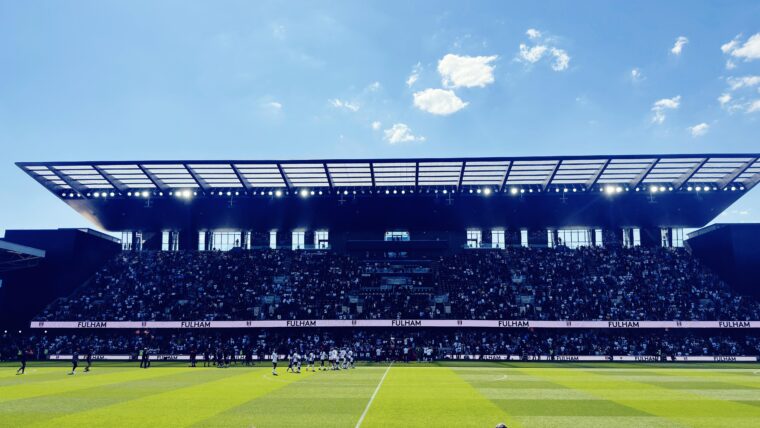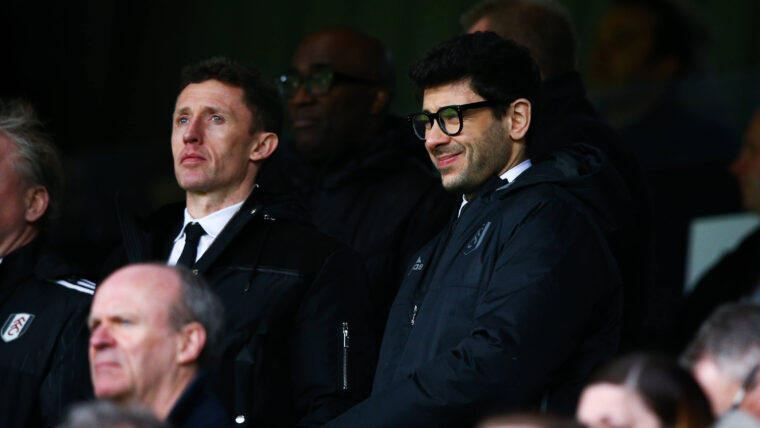Champagne by the Thames, silence in the stands: Fulham’s luxury gamble
14th May 2025

Jon Harland looks at the new Riverside stand and ponders the pros and cons.
As Fulham whimpered to a 3-1 defeat at the hands of Everton on Saturday, the mood around Craven Cottage was bleak. Just like that, the season was over. European qualification was within touching distance, but David Moyes’s outfit exposed the Whites’ soft underbelly, forcing some tough introspection. Did we even deserve Europe? Is missing out a blessing in disguise?
But it’s not all doom and gloom. Saturday marked the grand unveiling of the new Riverside hospitality stand. For a mere £20,000 per year, guests can now indulge in a Michelin-star inspired menu, sip champagne while overlooking the Thames, and lounge in an infinity pool (which currently has no water – and has no view of the pitch). Bargain.
The total cost of building the new Riverside stand is estimated to be £350m, and its completion confirms a hospitality increase from 600 to 2,300. It has nine different tiers of match-day hospitality, culminating in the newly opened £20,000 Sky Deck — the apex of modern football gluttony and decadence.
Sustainable growth
What’s interesting from reports of the unveiling is a minimal mention of Fulham FC and sparse memorabilia; just a few logos and discreet black and white colouring.
Project director Glen Sutton told BBC Sport: “We thought way less about the average football experience. The design of this is much more similar to world-class hotels, cruise ships or restaurants than anything in football.”
Built on the Soho House model, Fulham has also introduced a private members club in the new stand, with annual membership costing between £750 and £1,000. This includes access to a spa, hotel rooms, and a pool, but not access to the games, with just 20% to 30% of members interested in paying for matches alongside their membership.
Sutton said: “This development creates revenue streams that are important for the financial sustainability of a historic club like this. By opening for 365 days a year, we can ensure we keep the best staff away from restaurants and hotels in the city, which other sections of the entertainment sector struggle with.”
Given the Whites’ £32 million pre-tax loss in the year leading up to June 2024, extra methods of income are undeniably necessary.
How are match-going fans affected?
Whether or not there’s a direct correlation, both season ticket and matchday prices have steadily risen throughout the Riverside’s development. Since 2022, Fulham season tickets have increased incrementally: up 10% in 2022, 18% in 2023, 4% last season, and 2.8% ahead of the 2025/26 campaign.
While this year’s rise isn’t as steep as feared, the upward trend is undeniable. Matchday tickets have also surged by 18% last season alone. This term, single-match prices have hit £80 in the Hammersmith and Putney Ends, more than £100 in the Johnny Haynes Stand, and an eye-watering £160 in the Riverside.
Fulham Supporters Trust chair Simon Duke told Mail Sport: “We’re very pleased to see an asset that adds to the ground and will hopefully generate income to close the financial sustainability gap.
“But we will always continue to make a point on pricing in other parts of the ground, irrespective of what they may charge in the Riverside,” he added.
If millionaires with little emotional investment in Fulham want to stuff their faces with caviar and oysters every other Saturday, fine. As long as it doesn’t affect match-going fans, who are the heartbeat of this club.
Club direction: rebranded for the elite?
While hundreds of millions have been invested in the Riverside, other stands, particularly the Hammersmith End, desperately need upgrading. But despite being full of loyal Fulham fans, these stands are not the priority.
Why would they be? The average supporter brings in far less match day revenue than wealthy day-trippers and tourists, who mainly reside in the Riverside, eagerly purchasing merchandise at the club shop, and happy to pay extortionate prices for match tickets. Under CEO Alistair Mackintosh’s business model, Fulham’s ideal demographic is clear.
Fans without season tickets hoping to attend the occasional game are increasingly priced out. The lack of emphasis on Fulham and football in the new stand only reinforces the precedent we already feared the club was heading: treating attendees like customers, not supporters.
Luring a high-spending clientele may bring short-term financial gains. But over time, the cost is crucial. The atmosphere will continue to fade. Lifelong fans will disappear. And a new generation of Fulham fans will never emerge.
The new hospitality stand is symbolic of the club’s attitude of overlooking the fan base that defines the very fabric of it. There have already been protests in recent years, and it seems like the gap between supporters and those at the top, who have never been more out of touch, is growing wider.


